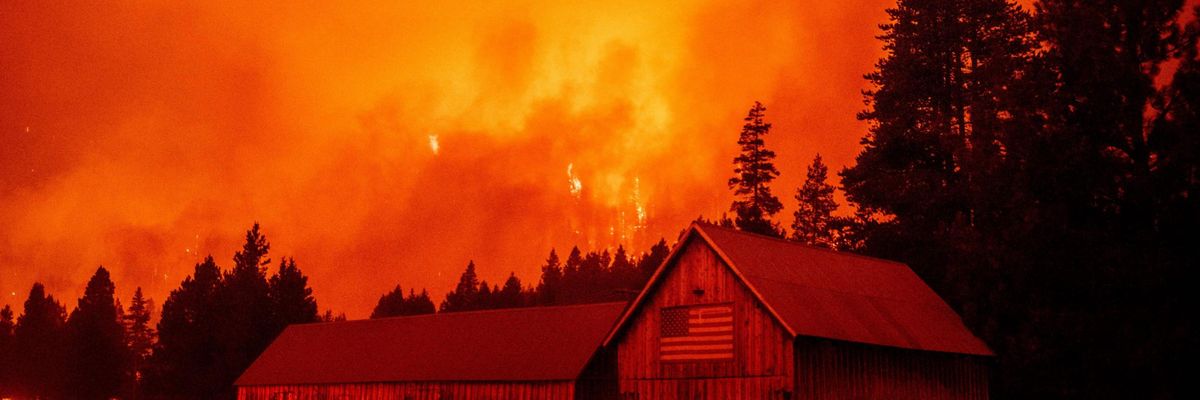
Flames rip across a hillside behind a building donning a U.S. flag as the Caldor Fire pushes into South Lake Tahoe, California on August 30, 2021. (Photo: Josh Edelson/AFP via Getty Images)
'Horrific' Caldor Fire Forces South Lake Tahoe Residents to Evacuate
"We are in a climate emergency," one meteorologist said in response to the massive blaze.
California's Caldor Fire forced tens of thousands of people to flee South Lake Tahoe on Monday, an extreme weather disaster that experts said provides further evidence of the need to rapidly slash greenhouse gas emissions and transition to clean energy.
"Wildfire season in the West is still producing horrific scenes daily."
--Eric Holthaus, meteorologist
The Caldor Fire, one of 83 large blazes currently torching the U.S. West, has burned more than 191,000 acres and is just 16% contained. The rapid growth of the fire, which began on August 14, prompted more evacuation warnings over the weekend, and those were soon upgraded to evacuation orders.
While "nearly 30,000 residents had already been evacuated from the eastern half of El Dorado County," The Sacramento Bee reported that "the entire city of South Lake Tahoe and surrounding areas along the west and south shores were ordered to evacuate" on Monday morning, just hours before the Caldor Fire entered the Lake Tahoe Basin.
Most South Lake Tahoe evacuees were on the road by 11:00 am PT on Monday, according to the newspaper, "with stragglers rushing to get their belongings into vehicles."
"Police drove through residential areas, using loudspeakers and sirens to order people to leave and directing them to head north on heavily congested Highway 50, along the east shore of Tahoe, as the main route out of town," The Sacramento Bee reported.
Jason Pohl, a journalist at the newspaper, called the miles of standstill traffic "an emergency manager's nightmare."
\u201cAn emergency manager\u2019s nightmare: Gridlock in South Lake Tahoe as residents evacuate the #CaldorFire. \n\nOne motorist just told me it\u2019s like this all the way to Kingsbury (about 6 miles away on Hwy 50). \n\nAbsolutely zero movement.\u201d— Jason Pohl (@Jason Pohl) 1630352333
Hours after almost all of South Lake Tahoe's roughly 22,000 residents fled, "the fire pushed beyond Echo Summit and into Christmas Valley, a few miles south of the city, intensifying fears about the danger to populated areas along the south shore of the lake," The Sacramento Bee noted.
By Monday evening, flames had jumped Highway 88 and Highway 89, according to reporters at the newspaper, who added Tuesday that "winds and critically dry conditions could continue to push the Caldor Fire deeper into the basin." The fire, which has already destroyed close to 500 homes, is now threatening approximately 34,000 buildings.
Both California Gov. Gavin Newsom (D) and Nevada Gov. Steve Sisolak (D) declared states of emergency on Monday, as officials worry that flames from the Caldor Fire could cross state lines in the coming days. In addition, the U.S. Forest Service is closing all national forests in California from Tuesday night through at least September 17 as a precautionary measure.
University of California, Los Angeles climate scientist Park Williams told the New York Times earlier this summer that "we wouldn't be seeing this giant ramp up in fire activity as fast as it is happening without climate change."
As a result of the U.S. West's worsening drought and record-shattering heatwaves--just some of the extreme weather that scientists have linked to carbon pollution--very dry fuel is abundant throughout the region. The combination of low precipitation and high temperatures has created the conditions for an especially catastrophic wildfire season that experts warn is not over.
"Wildfire season in the West is still producing horrific scenes daily," said meteorologist Eric Holthaus. "Due to climate warming, wildfires are burning higher up mountains than ever before."
"Earlier this summer, the Dixie Fire--now the largest single fire in California history--became the first wildfire in recorded history to cross the crest of the Sierra mountain range," Holthaus continued. Just a few weeks later, the Caldor Fire became the second blaze to make it from one side of the Sierra Nevada to the other.
California's Office of Emergency Services, meanwhile, lost access to a Louisiana National Guard helicopter crew that had arrived last week to help contain the fire but was forced to return home to respond to Hurricane Ida.
"We are in a climate emergency," said Holthaus.
The Sierra-at-Tahoe ski resort, Holthaus noted, used snowmaking equipment in an attempt to slow the spread of the Caldor Fire, which is 60 times bigger than the 2007 Angora Fire, previously the worst fire in the Lake Tahoe area.
\u201cOn Monday a ski lodge at Lake Tahoe turned on their snow-making equipment in a last-ditch effort to save their buildings from an advancing megafire.\n\nThe Caldor Fire is ~60x bigger than any other fire ever near Tahoe.\n\nThis is not normal. None of this is supposed to be happening.\u201d— Eric Holthaus (@Eric Holthaus) 1630369623
Monday's evacuation of South Lake Tahoe coincided with the beginning of search and rescue efforts in Louisiana, after Hurricane Ida left more than one million people without power, possibly for weeks.
In response, environmental justice advocates urged President Joe Biden to take serious steps to confront the fossil fuel-driven climate crisis.
"What more do politicians need to realize that the climate crisis is here and killing us?" asked Varshini Prakash, executive director of the Sunrise Movement. "The time for incrementalism and watered down 'solutions' is over."
"Biden must declare a climate emergency to mobilize the federal government towards addressing these climate disasters and tackling the climate crisis head on," Prakash added.
An Urgent Message From Our Co-Founder
Dear Common Dreams reader, The U.S. is on a fast track to authoritarianism like nothing I've ever seen. Meanwhile, corporate news outlets are utterly capitulating to Trump, twisting their coverage to avoid drawing his ire while lining up to stuff cash in his pockets. That's why I believe that Common Dreams is doing the best and most consequential reporting that we've ever done. Our small but mighty team is a progressive reporting powerhouse, covering the news every day that the corporate media never will. Our mission has always been simple: To inform. To inspire. And to ignite change for the common good. Now here's the key piece that I want all our readers to understand: None of this would be possible without your financial support. That's not just some fundraising cliche. It's the absolute and literal truth. We don't accept corporate advertising and never will. We don't have a paywall because we don't think people should be blocked from critical news based on their ability to pay. Everything we do is funded by the donations of readers like you. Will you donate now to help power the nonprofit, independent reporting of Common Dreams? Thank you for being a vital member of our community. Together, we can keep independent journalism alive when it’s needed most. - Craig Brown, Co-founder |
California's Caldor Fire forced tens of thousands of people to flee South Lake Tahoe on Monday, an extreme weather disaster that experts said provides further evidence of the need to rapidly slash greenhouse gas emissions and transition to clean energy.
"Wildfire season in the West is still producing horrific scenes daily."
--Eric Holthaus, meteorologist
The Caldor Fire, one of 83 large blazes currently torching the U.S. West, has burned more than 191,000 acres and is just 16% contained. The rapid growth of the fire, which began on August 14, prompted more evacuation warnings over the weekend, and those were soon upgraded to evacuation orders.
While "nearly 30,000 residents had already been evacuated from the eastern half of El Dorado County," The Sacramento Bee reported that "the entire city of South Lake Tahoe and surrounding areas along the west and south shores were ordered to evacuate" on Monday morning, just hours before the Caldor Fire entered the Lake Tahoe Basin.
Most South Lake Tahoe evacuees were on the road by 11:00 am PT on Monday, according to the newspaper, "with stragglers rushing to get their belongings into vehicles."
"Police drove through residential areas, using loudspeakers and sirens to order people to leave and directing them to head north on heavily congested Highway 50, along the east shore of Tahoe, as the main route out of town," The Sacramento Bee reported.
Jason Pohl, a journalist at the newspaper, called the miles of standstill traffic "an emergency manager's nightmare."
\u201cAn emergency manager\u2019s nightmare: Gridlock in South Lake Tahoe as residents evacuate the #CaldorFire. \n\nOne motorist just told me it\u2019s like this all the way to Kingsbury (about 6 miles away on Hwy 50). \n\nAbsolutely zero movement.\u201d— Jason Pohl (@Jason Pohl) 1630352333
Hours after almost all of South Lake Tahoe's roughly 22,000 residents fled, "the fire pushed beyond Echo Summit and into Christmas Valley, a few miles south of the city, intensifying fears about the danger to populated areas along the south shore of the lake," The Sacramento Bee noted.
By Monday evening, flames had jumped Highway 88 and Highway 89, according to reporters at the newspaper, who added Tuesday that "winds and critically dry conditions could continue to push the Caldor Fire deeper into the basin." The fire, which has already destroyed close to 500 homes, is now threatening approximately 34,000 buildings.
Both California Gov. Gavin Newsom (D) and Nevada Gov. Steve Sisolak (D) declared states of emergency on Monday, as officials worry that flames from the Caldor Fire could cross state lines in the coming days. In addition, the U.S. Forest Service is closing all national forests in California from Tuesday night through at least September 17 as a precautionary measure.
University of California, Los Angeles climate scientist Park Williams told the New York Times earlier this summer that "we wouldn't be seeing this giant ramp up in fire activity as fast as it is happening without climate change."
As a result of the U.S. West's worsening drought and record-shattering heatwaves--just some of the extreme weather that scientists have linked to carbon pollution--very dry fuel is abundant throughout the region. The combination of low precipitation and high temperatures has created the conditions for an especially catastrophic wildfire season that experts warn is not over.
"Wildfire season in the West is still producing horrific scenes daily," said meteorologist Eric Holthaus. "Due to climate warming, wildfires are burning higher up mountains than ever before."
"Earlier this summer, the Dixie Fire--now the largest single fire in California history--became the first wildfire in recorded history to cross the crest of the Sierra mountain range," Holthaus continued. Just a few weeks later, the Caldor Fire became the second blaze to make it from one side of the Sierra Nevada to the other.
California's Office of Emergency Services, meanwhile, lost access to a Louisiana National Guard helicopter crew that had arrived last week to help contain the fire but was forced to return home to respond to Hurricane Ida.
"We are in a climate emergency," said Holthaus.
The Sierra-at-Tahoe ski resort, Holthaus noted, used snowmaking equipment in an attempt to slow the spread of the Caldor Fire, which is 60 times bigger than the 2007 Angora Fire, previously the worst fire in the Lake Tahoe area.
\u201cOn Monday a ski lodge at Lake Tahoe turned on their snow-making equipment in a last-ditch effort to save their buildings from an advancing megafire.\n\nThe Caldor Fire is ~60x bigger than any other fire ever near Tahoe.\n\nThis is not normal. None of this is supposed to be happening.\u201d— Eric Holthaus (@Eric Holthaus) 1630369623
Monday's evacuation of South Lake Tahoe coincided with the beginning of search and rescue efforts in Louisiana, after Hurricane Ida left more than one million people without power, possibly for weeks.
In response, environmental justice advocates urged President Joe Biden to take serious steps to confront the fossil fuel-driven climate crisis.
"What more do politicians need to realize that the climate crisis is here and killing us?" asked Varshini Prakash, executive director of the Sunrise Movement. "The time for incrementalism and watered down 'solutions' is over."
"Biden must declare a climate emergency to mobilize the federal government towards addressing these climate disasters and tackling the climate crisis head on," Prakash added.
California's Caldor Fire forced tens of thousands of people to flee South Lake Tahoe on Monday, an extreme weather disaster that experts said provides further evidence of the need to rapidly slash greenhouse gas emissions and transition to clean energy.
"Wildfire season in the West is still producing horrific scenes daily."
--Eric Holthaus, meteorologist
The Caldor Fire, one of 83 large blazes currently torching the U.S. West, has burned more than 191,000 acres and is just 16% contained. The rapid growth of the fire, which began on August 14, prompted more evacuation warnings over the weekend, and those were soon upgraded to evacuation orders.
While "nearly 30,000 residents had already been evacuated from the eastern half of El Dorado County," The Sacramento Bee reported that "the entire city of South Lake Tahoe and surrounding areas along the west and south shores were ordered to evacuate" on Monday morning, just hours before the Caldor Fire entered the Lake Tahoe Basin.
Most South Lake Tahoe evacuees were on the road by 11:00 am PT on Monday, according to the newspaper, "with stragglers rushing to get their belongings into vehicles."
"Police drove through residential areas, using loudspeakers and sirens to order people to leave and directing them to head north on heavily congested Highway 50, along the east shore of Tahoe, as the main route out of town," The Sacramento Bee reported.
Jason Pohl, a journalist at the newspaper, called the miles of standstill traffic "an emergency manager's nightmare."
\u201cAn emergency manager\u2019s nightmare: Gridlock in South Lake Tahoe as residents evacuate the #CaldorFire. \n\nOne motorist just told me it\u2019s like this all the way to Kingsbury (about 6 miles away on Hwy 50). \n\nAbsolutely zero movement.\u201d— Jason Pohl (@Jason Pohl) 1630352333
Hours after almost all of South Lake Tahoe's roughly 22,000 residents fled, "the fire pushed beyond Echo Summit and into Christmas Valley, a few miles south of the city, intensifying fears about the danger to populated areas along the south shore of the lake," The Sacramento Bee noted.
By Monday evening, flames had jumped Highway 88 and Highway 89, according to reporters at the newspaper, who added Tuesday that "winds and critically dry conditions could continue to push the Caldor Fire deeper into the basin." The fire, which has already destroyed close to 500 homes, is now threatening approximately 34,000 buildings.
Both California Gov. Gavin Newsom (D) and Nevada Gov. Steve Sisolak (D) declared states of emergency on Monday, as officials worry that flames from the Caldor Fire could cross state lines in the coming days. In addition, the U.S. Forest Service is closing all national forests in California from Tuesday night through at least September 17 as a precautionary measure.
University of California, Los Angeles climate scientist Park Williams told the New York Times earlier this summer that "we wouldn't be seeing this giant ramp up in fire activity as fast as it is happening without climate change."
As a result of the U.S. West's worsening drought and record-shattering heatwaves--just some of the extreme weather that scientists have linked to carbon pollution--very dry fuel is abundant throughout the region. The combination of low precipitation and high temperatures has created the conditions for an especially catastrophic wildfire season that experts warn is not over.
"Wildfire season in the West is still producing horrific scenes daily," said meteorologist Eric Holthaus. "Due to climate warming, wildfires are burning higher up mountains than ever before."
"Earlier this summer, the Dixie Fire--now the largest single fire in California history--became the first wildfire in recorded history to cross the crest of the Sierra mountain range," Holthaus continued. Just a few weeks later, the Caldor Fire became the second blaze to make it from one side of the Sierra Nevada to the other.
California's Office of Emergency Services, meanwhile, lost access to a Louisiana National Guard helicopter crew that had arrived last week to help contain the fire but was forced to return home to respond to Hurricane Ida.
"We are in a climate emergency," said Holthaus.
The Sierra-at-Tahoe ski resort, Holthaus noted, used snowmaking equipment in an attempt to slow the spread of the Caldor Fire, which is 60 times bigger than the 2007 Angora Fire, previously the worst fire in the Lake Tahoe area.
\u201cOn Monday a ski lodge at Lake Tahoe turned on their snow-making equipment in a last-ditch effort to save their buildings from an advancing megafire.\n\nThe Caldor Fire is ~60x bigger than any other fire ever near Tahoe.\n\nThis is not normal. None of this is supposed to be happening.\u201d— Eric Holthaus (@Eric Holthaus) 1630369623
Monday's evacuation of South Lake Tahoe coincided with the beginning of search and rescue efforts in Louisiana, after Hurricane Ida left more than one million people without power, possibly for weeks.
In response, environmental justice advocates urged President Joe Biden to take serious steps to confront the fossil fuel-driven climate crisis.
"What more do politicians need to realize that the climate crisis is here and killing us?" asked Varshini Prakash, executive director of the Sunrise Movement. "The time for incrementalism and watered down 'solutions' is over."
"Biden must declare a climate emergency to mobilize the federal government towards addressing these climate disasters and tackling the climate crisis head on," Prakash added.

